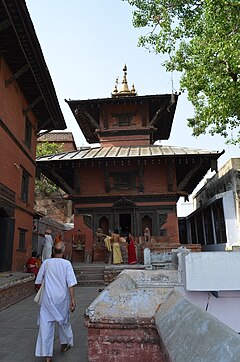Nepali Mandir
| Nepali Mandir नेपाली मंदिर |
|
|---|---|

Nepali Mandir in Varanasi
|
|
|
Temple location on Varanasi district map
|
|
| Name | |
| Devanagari | नेपाली मंदिर |
| Tamil | நேபாளி கோவில் |
| Bengali | নেপালি মন্দির |
| Geography | |
| Coordinates | 25°18′35″N 83°00′46″E / 25.309821°N 83.012859°ECoordinates: 25°18′35″N 83°00′46″E / 25.309821°N 83.012859°E |
| Country |
|
| State | Uttar Pradesh |
| District | Varanasi |
| Location | Lalita Ghat, Varanasi |
| Elevation | 78.161 m (256 ft) |
| Culture | |
| Primary deity | Lord Shiva |
| Important festivals |
Mahashivratri Nag Panchami |
| Architecture | |
| Architectural styles | Pagoda |
| History and governance | |
| Date built | 1843 |
| Creator |
Rana Bahadur Shah & Girvan Yuddha Bikram Shah Deva (King of Nepal) |
Nepali Mandir (Hindi: नेपाली मंदिर), also known as (a.k.a. Kanthwala Mandir and Mini Khajuraho) (Kanthwala in Hindi means wooden), is one of the oldest and most famous temples in the holy city of Varanasi. This temple has great religious importance in Hinduism and is dedicated to the Lord Shiva. Constructed in the 19th century A.D by the King of Nepal, the temple is made of terracotta, stone and wood and is replica of the Pashupatinath Temple in Kathmandu.
 King of Nepal, Rana Bahadur Shah took exile in Varanasi from 1800 to 1804 and titled himself as "Swami Nirgunanda". During his exile, he decided to build a replica of Pashupatinath Temple in Varanasi. Construction of the temple commenced during his exile / stay in Varanasi. During the construction, Shah moved back to Nepal. On April 25, 1806, Rana Bahadur Shah was stabbed to death by his stepbrother, Sher Bahadur Shah. His son Girvan Yuddha Bikram Shah Deva completed the project 20 years after the deadline. The land was later transferred to Rana Bahadur Shah by Kashi Naresh in the year 1843. The temple, adjacent area, Lalita Ghat and a dharamshala, belongs to the Nepal government.
King of Nepal, Rana Bahadur Shah took exile in Varanasi from 1800 to 1804 and titled himself as "Swami Nirgunanda". During his exile, he decided to build a replica of Pashupatinath Temple in Varanasi. Construction of the temple commenced during his exile / stay in Varanasi. During the construction, Shah moved back to Nepal. On April 25, 1806, Rana Bahadur Shah was stabbed to death by his stepbrother, Sher Bahadur Shah. His son Girvan Yuddha Bikram Shah Deva completed the project 20 years after the deadline. The land was later transferred to Rana Bahadur Shah by Kashi Naresh in the year 1843. The temple, adjacent area, Lalita Ghat and a dharamshala, belongs to the Nepal government.
...
Wikipedia

